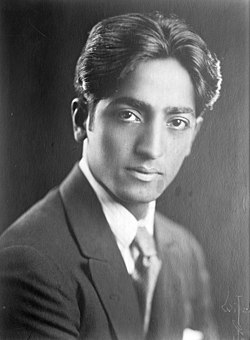Jiddu Krishnamurti
Jiddu Krishnamurti (11 May 1895 – 17 February 1986) was an Indian-born speaker on philosophical and spiritual subjects. His career had two clearly distinct stages. In the first, he was the pupil and eventually leader of the new religious movement known as Theosophy. In the second part he rejected Theosophy and every belief associated with it, saying: "I maintain that truth is a pathless land, and you cannot approach it by any path whatsoever, by any religion, by any sect".
Jiddu Krishnamurti | |
|---|---|
 Krishnamurti 1920s | |
| Born | 11 May 1895 |
| Died | 17 February 1986 (aged 90) |
| Cause of death | Pancreatic cancer |
| Occupation | public speaker, mystic, author, philosopher |
| Wikimedia Commons has media related to Lua error in Module:Commons_link at line 62: attempt to index field 'wikibase' (a nil value).. |
Theosophy
Krishnamurti was born into a Brahmin family in what was then British India. In early adolescence, he had a chance encounter with prominent occultist and high-ranking theosophist Charles Webster Leadbeater in the grounds of the Theosophical Society headquarters at Adyar in Madras (now Chennai). He was subsequently raised by Annie Besant and Leadbeater, leaders of the Society at the time. They believed him to be a "vehicle" for an expected World Teacher.[1] While he was young, Besant had control over his life, and won a court case for custody of Krishnamurti and his brother.
Freedom
As a young man, Krishnamurti disavowed Theosophy and dissolved the worldwide organization (the Order of the Star in the East) established to support it. He resigned from the various trusts and other organizations which were affiliated with Order of the Star, and the Theosophical Society. He returned the monies and properties donated to the Order, among them a castle in the Netherlands and 5,000 acres (20 km2) of land, to their donors.[2]
From then on he claimed allegiance to no nationality, caste, religion, or philosophy. He spent the rest of his life travelling the world, speaking to large and small groups and individuals. He authored many books, among them The First and Last Freedom, The Only Revolution, and Krishnamurti's Notebook. Many of his talks and discussions have been published.[3]
Krishnamurti did not accept followers nor worshippers. He thought the relationship between disciple and guru encouraged dependency and exploitation. He accepted gifts and financial support freely offered to him by people inspired by his work, and continued with lecture tours and the publication of books and talk transcripts for more than half a century.[4]
He constantly urged people to think independently, and he invited them to explore and discuss specific topics together with him.[5][6] His subject matter included: psychological revolution, the nature of mind, meditation, inquiry, human relationships, and bringing about change in society. He stressed the need for a revolution in the psyche of every human being and emphasized that such revolution cannot be brought about by any external entity, be it religious, political, or social.
His supporters, working through non-profit foundations in India, Great Britain and the United States, oversee several independent schools based on his views on education. They continue to transcribe and distribute his thousands of talks, group and individual discussions, and writings by use of a variety of media formats and languages.
Jiddu Krishnamurti Media
House in Madanapalle, in which Krishnamurti was born
Krishnamurti by Tomás Povedano
KFI retreat session at Rishi Valley on 17 November 2019, Padmanabhan Krishna addressing the gathering, with Radhika Herzberger presiding
References
- ↑ variously known as the Ascended Master, Master of the Ancient Wisdom, Mahatma
- ↑ Lutyens, Mary 1975. Krishnamurti: the years of awakening. New York: Farrar Straus and Giroux. ISBN 978-0-374-18222-9.
- ↑ Lutyens, Mary 1983. Krishnamurti: the years of fulfilment. New York: Farrar Straus and Giroux. ISBN 978-0-374-18224-3
- ↑ Krishnamurti Foundations (1997) includes a chronology and a listing of places he visited and spoke at from 1911 to 1986.
- ↑ Jiddu Krishnamurti 1965. Tenth public talk at Saanen. Krishnamurti Online: Krishnamurti Foundations.[1] Archived 2012-10-19 at the Wayback Machine
- ↑ Jiddu Krishnamurti 1969. Freedom from the known. Lutyens, Mary (ed) Harper: SanFrancisco. ISBN 978-0-06-064808-4 [2] Archived 2012-03-17 at the Wayback Machine





